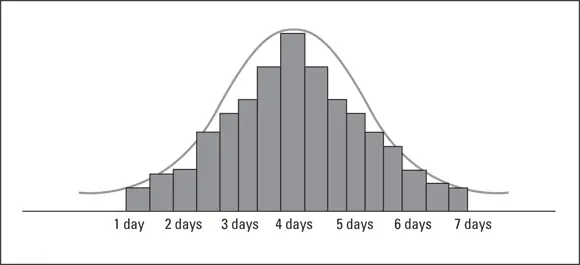Taking the strain out of constraints
Much of the focus in Lean thinking is on understanding and improving the flow of processes and eliminating non-value-added activities. Eliyahu Goldratt’s theory of constraints (explained more fully in Chapter 11) provides a way to address and tackle bottlenecks that slow the process flow. By addressing what is getting in the way, you can enable a smooth flow, and deliver value to the customer.
The customer, not your organization, specifies value. Value is what your customer is willing to pay for. To satisfy your customer, your organization has to provide the right products and services, at the right time, at the right price and at the right quality. To do this, and to do so consistently, you need to identify and understand how your processes work, improve and smooth the flow, eliminate unnecessary steps in the process, and reduce or prevent waste such as rework.
Imagine the processes involved in your own organization, beginning with a customer order (market demand) and ending with cash in the bank (invoice or bill paid). Ask yourself the following questions:
How many steps are involved?
Do you need all the steps?
Are you sure?
How can you reduce the number of steps and the time involved from start to finish?
Perusing the principles of Lean thinking
Lean thinking has five key principles:
Understand the customer and their perception of value.
Identify and understand the value stream for each process and the waste within it.
Enable the value to flow.
Let the customer pull the value through the processes, according to their needs.
Continuously pursue perfection (Continuous Improvement).
You’ll see that the principles are universal, as they apply to any type of process in any type of organization. They are also timeless, as they’re as relevant now as they ever were. In Chapter 2, we show how the principles combine with the key principles of Six Sigma to form Lean Six Sigma .
Six Sigma is a systematic and robust approach to improvement, which focuses on the customer and other key stakeholders. Six Sigma seeks to improve processes so that they deliver consistent, reliable outputs. It was developed in the 1980s within Motorola and was widely used by General Electric. When Jack Welch, former General Electric CEO, introduced Six Sigma, he said:
We are going to shift the paradigm from fixing products to fixing and developing processes, so they produce nothing but perfection or close to it.
Considering the key elements of Six Sigma
Some simple principles underpin Six Sigma:
Understand the CTQs of your customers and stakeholders. To deliver the best customer experience, you need to know who your customers are and what they want — their requirements and expectations. CTQ is short for Critical To Quality, and CTQs are the performance requirements that matter most to your customers. To understand these you need to listen to and understand the voice of the customer (VOC). Chapter 4contains more information on these important elements.
Understand your organization's processes and ensure they reflect your customers’ CTQs. You need to know how your processes work and what they’re trying to achieve. A clear objective for each process should exist, focused on the customer requirements (the CTQs).
Manage by fact and reduce variation. Measurement and management by fact enables more effective decision-making. By understanding variation, you can work out when and when not to take action.
Involve and equip the people in the process. To be truly effective you need to equip the people in your organization to be able, and to feel able, to challenge and improve their processes and the way they work.
Undertake improvement activity in a systematic way. Working systematically helps you avoid jumping to conclusions and solutions. Six Sigma uses a process called DMAIC (Define, Measure, Analyze, Improve and Control) to improve existing processes. We cover DMAIC in Chapter 2. In designing new processes, we use DMADV (which is covered in Chapter 14).
You’ll recognize some similarities with the principles of Lean outlined earlier in the chapter, and some new concepts. Let’s look at those concepts in a little more detail, focusing on measurement and variation in particular. Some of the content might seem a little heavy — we want you to have a clear explanation of the concepts — but remember that pragmatism is a theme of this book.
Getting to grips with variation
The standard deviation is a measure that reveals the amount of variation. It is represented as the lower-case Greek letter  (sigma) and describes the average dispersal of the individual data points from their overall average. Why is this helpful? The smaller the standard deviation value is, the less variation there is. Conversely, the larger the value, the more variation. By understanding the amount and type of variation in our results, we can get closer to understanding the “behavior” of the process (or the thing we are measuring) and what this means for customers.
(sigma) and describes the average dispersal of the individual data points from their overall average. Why is this helpful? The smaller the standard deviation value is, the less variation there is. Conversely, the larger the value, the more variation. By understanding the amount and type of variation in our results, we can get closer to understanding the “behavior” of the process (or the thing we are measuring) and what this means for customers.
Introducing a simple example
Suppose you want to understand the cycle time (lead time) of a process in your organization in days. You could collect a representative sample of data (more on sampling in Chapter 7), and from that sample, calculate the average (or mean) number of days. Calculating the average difference between each cycle time in your data set and the overall average cycle time will give you the standard deviation. The standard deviation is always expressed as the same unit as the “thing” you are measuring; in this case we’re talking about days.
Figure 1-2 shows the time taken to process the orders. The cycle time varies from as short as one day to as long as seven days. Each of the data points represents a customer’s experience of the process. As well as seeing how much performance varies, you can also see the “shape” of the data. This data looks normally distributed. In a normal distribution, the shape is symmetrical around the mean, and the data has a 50-percent chance of falling either side of it. Sometimes this shape is referred to as a bell curve or a Gaussian distribution. Many things that are measured fall into this shape — for example, the heights of people, the size of snowflakes, and IQ scores.

© Martin Brenig-Jones and Jo Dowdall
FIGURE 1-2:Histogram showing the time taken to process orders.
When the data is normally distributed, we can understand the likely percentage of the population within plus one or minus one standard deviation from the average (or mean), plus two or minus two standard deviations from the average, and so on. Assuming your sample is representative, you can see how your data provides a good picture of the process cycle time. You find that approximately two-thirds of them are between 3 days and 5 days, about 95 percent are in the range of 2 days to 6 days, and about 99.73 percent are between 1 day and 7 days. This is illustrated in Figure 1-3.
The formula used to calculate the standard deviation is shown in Figure 1-4. It looks a little scary at first glance, but as with all formulas, when you start to break it down it becomes more accessible.
Читать дальше

 (sigma) and describes the average dispersal of the individual data points from their overall average. Why is this helpful? The smaller the standard deviation value is, the less variation there is. Conversely, the larger the value, the more variation. By understanding the amount and type of variation in our results, we can get closer to understanding the “behavior” of the process (or the thing we are measuring) and what this means for customers.
(sigma) and describes the average dispersal of the individual data points from their overall average. Why is this helpful? The smaller the standard deviation value is, the less variation there is. Conversely, the larger the value, the more variation. By understanding the amount and type of variation in our results, we can get closer to understanding the “behavior” of the process (or the thing we are measuring) and what this means for customers.











